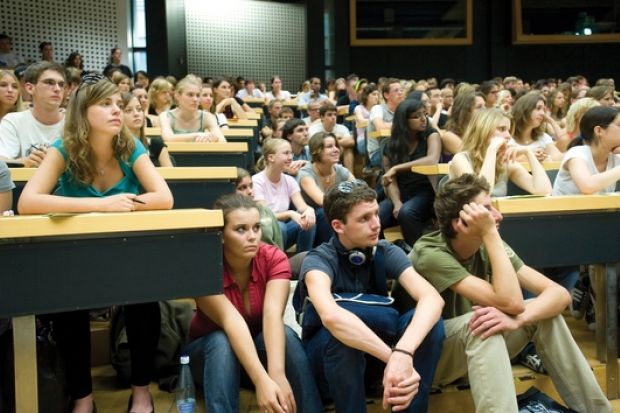Class sizes at universities are significantly larger than official figures suggest because many academics described as teachers actually spend most of their time doing research, a study has found.
The report by Stephen Court, senior research officer at the University and College Union, found that overcrowding at universities may be significantly under-reported because a key official measure of class sizes - the student-to-staff ratio (SSR) - is unreliable.
That was because the majority of staff included in the ratio were “teaching-and-research academics” who are classed as spending all their time on teaching but actually devote as little as one day a week to it.
It means that the average student-to-staff ratio - estimated at 17 students per lecturer for UK universities, based on data from the Higher Education Statistics Agency - is likely to be inaccurate, said Mr Court.
Including research-oriented staff in the ratio may also distort the position of UK universities in league tables, says his report, An Analysis of Student-Staff Ratios and Academics’ Use of Time and Potential Links with Student Satisfaction.
‘Distorted view’
“It potentially affects the decision of thousands of prospective students about choosing courses costing up to £9,000 a year in tuition fees, as well as the decisions of governments and accrediting bodies,” the paper says.
“It is potentially misleading because a low student-staff ratio gives the impression of high teacher availability at institutions where academics may in fact be rather unavailable because of their extensive commitment to research activities.”
Research-intensive universities, which “come out best on SSRs”, were more likely to present a distorted view of class sizes than teaching-focused institutions, says the report.
For instance, staff at the University of Cambridge counted as full-time teachers in the calculation of its SSR - 11.7 students to one academic - actually devoted only 22 per cent of their time to it, according to data from the Transparent Approach to Costing survey 2009-10, which tracks the use of academics’ time.
At the University of Oxford, where there were 10.8 students per academic member, “teaching” staff devoted only 25 per cent of their time to teaching, according to Trac.
At Imperial College London the figure was 21 per cent and at the London School of Economics it was 22 per cent.
At universities in the Russell Group, which have “some of the lowest student-staff ratios in UK universities” according to a report released by the group in October, the figure was 23.7 per cent on average (Trac 2008-09).
Meanwhile, at the more teaching-focused institutions such as the University of Salford, which had 23.7 students per academic, staff spent more than twice as much time teaching - 55 per cent of their working hours (Trac 2009-10).
At Bournemouth University, where there were 23.6 students per teaching academic, staff devoted 56 per cent of their time to teaching.
The figures exclude time spent on administration and management supporting teaching and research, which accounted for nearly 32 per cent of academics’ time at almost all institutions in 2008-09.
Although universities tend not to advertise specific student-to-staff ratios, the measure is widely referenced by groups such as Universities UK and the Higher Education Funding Council for England.
Several professional bodies that regulate courses - such as the General Medical Council and the General Dental Council - also refer to the ratio. Others insist on a maximum ratio for courses they accredit.
The General Optical Council, for example, requires institutions to have no more than 16 students per staff member.
Recalibrated
Over-representing the amount of teaching resource available at UK universities could endanger their standing with such professional organisations and diminish the UK’s international reputation for teaching quality, says the report, which will be unveiled at the Society for Research into Higher Education’s annual conference at Celtic Manor, in Newport, Wales, next week.
A recalibrated SSR that reflects staff’s research commitments would paint a more accurate picture of the demands placed on teaching staff as well as the resources available to students, the document says.
However, David Palfreyman, director of the Oxford Centre for Higher Education Policy Studies, believes that students may be willing to accept higher class sizes if their university scored highly on research.
“The student is, arguably, buying the brand, and the brand value of their university is mostly dictated by its research global ranking,” he said.
“Might students be content with…limited teaching so long as their university’s research reputation is enhanced?”




